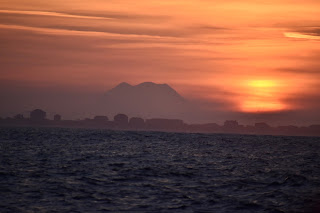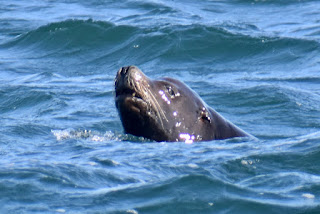Westport, WA 9/24 - 9/29, Part 3
Finally, after five days the rain stopped and the ocean was kind enough to allow boats to return to work. The main purpose of our Washington trip was to get out on this pelagic venture and now it was time. We were the first participants to arrive at the dock, or float as the western locals called it. We were sailing on the Monte Carlo from Float 10. The Monte Carlo is about a 50-foot vessel, smaller than the pelagic boats we are used to riding on the East coast. There were only 18 participants for this ride, so comfort wasn’t a problem. After a brief introduction and orientation, we set off at about 6:30 a.m. The seas seemed much better than the forecasted five to six foot swells.
As we made our way out of the inlet onto the Pacific, we slowly began picking up seabirds. The early checklist for the inshore portion included scoters, western grebes, common and pacific loons. A few alcids, like common murre and rhinoceros auklet, were also seen close to shore. The common murres and rhinos (as the spotters called them) were seen often throughout the day. It would be safe to say that we saw more common murres during the week than any of the three of us would see over our lifetimes back in New Jersey. The staff told us that several shrimp and fishing boats were working out in the deeper water, and that’s where we would head. The working boats are magnets for seabirds, much better than the birding boat creating its own chum slick.
As we headed further out, we began picking up sooty shearwaters. I didn’t take many photos of them since I’ve seen plenty on the Right Coast. That was my mistake because as the spotters pointed out some short-tailed shearwaters (one of six new life birds on the day), they looked quite similar to sooties, I could have sorted out the two later in photos. We had nearly a thousand sooties on the day and only about a dozen short-tails. We had some distant south polar skuas as we headed towards deeper water but got great looks of a pair later in the day that hung close to the boat for a bit.
As we got closer to a pair of shrimp boats, the bird numbers and variety increased. More new life birds appeared: pink-footed shearwaters, Buller’s shearwaters and Cassin’s auklets. Some familiar birds were around too: red and red-necked phalaropes, parasitic and pomarine jaegers, and northern fulmars. The recently acquainted fork-tailed storm-petrels were now more abundant and closer to view. Close to the shrimp boats there were many birds picking at the scraps created by the fishermen’s process of catching and hauling in their quarry. Trailing the back of the fishing boats were many gulls and fulmars; some shearwaters and storm-petrels, and one life bird I really wanted to see - an albatross! A black-footed albatross, unmistakable with its long wings, glided gracefully around the foraging pack of smaller seabirds. We would get good looks at several of these awesome birds either sitting on the water or effortlessly gliding around our boat.
The last big Wow! moment of the trip came as the boat was approaching the inlet on the way back. A gray whale breached less than a few hundred feet directly in front of the boat. I’m sure everyone aboard saw it, but it happened so unexpectedly that no one got that photo. Without warning, the whale did an encore breach. All I was able to capture was its splash, but Jason got the money shot.


























Comments
Post a Comment